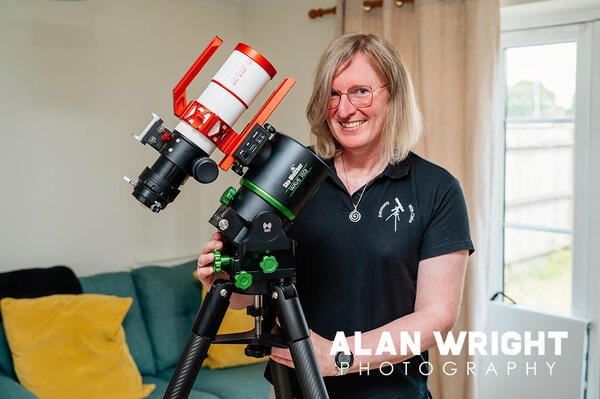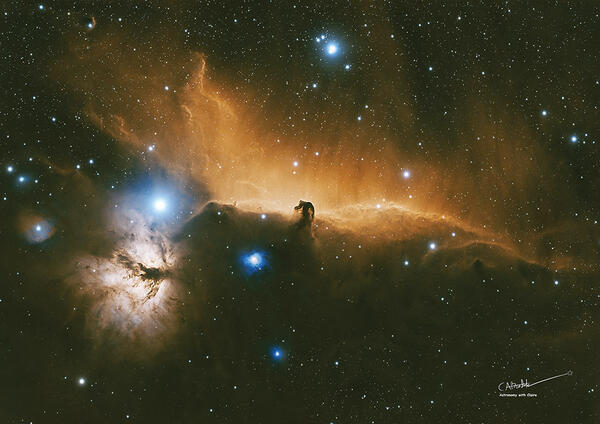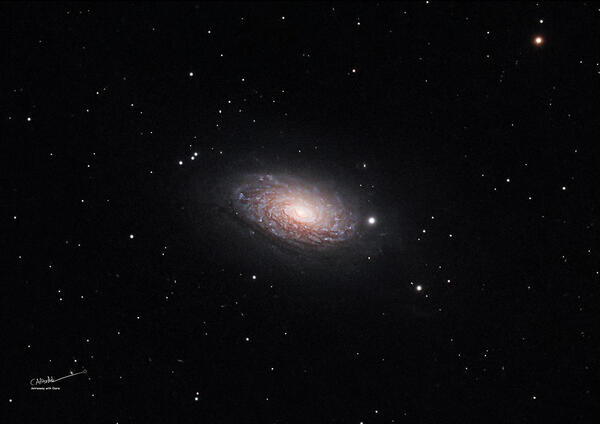ASTRO-PHOTOGRAPHER CLAIRE BRADSHAW

Published on 1st June 2025
Claire Bradshaw is an astro-photographer, science communicator and Fellow of the Royal Astronomical Society. Using telescopes in her garden, Claire captures galaxies, nebulae, stars and cosmic wonders light-years away, bringing them to life in photographic form. AAH met her to find out more...
Claire, where does your passion for astronomy come from?
As a child, I was fascinated by space: the sun, moon, planets, solar system and the stars in the night sky. Physics was my favourite subject at school and I studied it at A level too. However, mathematics is important in academic physics and that was something I struggled with. All these years later, I provide online education as an e-learning developer and one of the things I try to do is structure the course so that everyone can understand it. I leave calculus to the mathematicians and focus on astronomy. Hopefully that way, I can inspire others to embrace the subject.
How did you become an astro-photographer?
I never let the academic side hold me back and continued to enjoy astronomy as a hobbyist, becoming a Fellow of the Royal Astronomical Society. My interest in astro-photography developed alongside my scientific studies. However, as I was raising children with my former partner, I didn’t have the time or money to invest in expensive telescopic lenses that could capture pictures of deep space, so initially I used a basic digital SLR camera. One day, a friend called me seeking advice for someone interested in astro-photography. They asked me what equipment I would buy if I had the money, and I reeled off details of cameras, lenses, telescopes, filters and star trackers. Two weeks later, all this equipment arrived at my front door. It transpired that my friend had won some money and had bought everything I needed. I’ll be forever grateful as this kick-started my career as an astro-photographer.
Do you focus on one aspect of space?
In the same way that you have photographers who specialists in cityscapes or landscapes, and others adopting different techniques for wildlife or sports, there are many fields of astro-photography. My interest is deep space, capturing galaxies, black holes and phenomena such as nebulae, which are clouds of gas and dust in space. Some prefer planetary photography, capturing the sun, moon and planets within our solar system, the Milky Way. When shooting planets, photographers rely on a technique called ‘lucky imaging’ to overcome atmospheric interference. When you look closely at the sun or a planet through a telescope, you will see they are not static objects; they are always moving. It’s like a swimming pool, which looks still and blue from far away, but as you get closer, you see that the water is moving, causing ripples and reflecting light. Capturing a clear, concise image is very difficult, so by taking hundreds or even thousands of images, astro-photographers use ‘lucky imaging’, saving the best ones and discarding the rest to give them incredible pictures of Saturn’s rings or Jupiter’s Great Red Spot.

What does deep space offer a photographer?
One of my favourite photos is of the Andromeda galaxy. There are three galaxies in our ‘Local Group’ which include the Milky Way, Triangulum (or Messier 33) and Andromeda (Messier 31). Andromeda is a bigger galaxy than ours, with a trillion stars compared to about 400 billion in the Milky Way. These are numbers that are difficult to grasp, and one of the challenges I have is conveying that sense of scale. It’s extremely hard to express the size of space in comparison to Earth. For example, if our sun was 22cm wide, the Earth would be just 2mm wide, and there are far bigger stars out there than the sun.
How do you capture nebulae?
With nebulae, you are trying to capture elements such as hydrogen, oxygen and sulphur that are invisible to the naked eye. Most people will recognise the Orion constellation in the night sky, but around Orion’s belt is The Horsehead Nebula, which can only be seen through a telescope. It has the shape of a horse’s head and makes for great photographs. Images of nebulae also reveal stars that are not visible to human eyes, and they all have different levels of brightness. A bright spot indicates a new star, whilst older stars turn orange or red. By using specialist photography filters, the ionised hydrogen gas reveals itself as an orangey hue, while the oxygen is represented as blue and the sulphur as a deep red colour, creating a beautiful contrast.
What is the process behind your final photographs and fine art prints?
This is difficult to explain, as I realised when I exhibited at a local art fair as a member of Horsham Artists. To compile a complete image, I set up my telescopes to focus on a single point in the night sky – a nebula, for example – then I track it with precision as the Earth rotates. Every five minutes, the camera takes an image, which is stored digitally. This process is repeated for several hours or sometimes longer, taking 12 photos every hour. The software has sensors which alert you to changes in the weather conditions, which can delay a shoot too. I use narrowband filters to take three different images every time, capturing the hydrogen, oxygen and sulphur gases individually. So, after several hours, it all adds up to a lot of images! However, the software is able to take all the shots and layer them together, like a digital sandwich, giving you the best overall image of this one spot in the universe, capturing a snapshot in time. It’s fascinating to think that the Horsehead Nebula is 1,375 light years away, so what we are seeing on Earth is light from the 7th Century. The sky is a museum of time and nothing ever happens all at once.
How much is done in post-production?
There is a lot to do before a photo is finished. Firstly, it’s important to remove satellites, as Elon Musk’s SpaceX alone operates over 7,000. The processing software combines images taken by each filter, then aligns and compresses them to create a black and white image. The computer software doesn’t understand a histogram, which is the graphical representation of the tonal distribution of an image. So, an astro-photographer uses a histogram to reveal the true colours of those faint celestial details, such as the gases in a dust cloud. This is the most exciting part of the process, when the images reveal their beauty.

How do you know where to point the camera?
There is a worldwide astronomical community that communicates on social media. One amateur astronomer in Japan, Koichi Itagaki, specialises in discovering supernovas, scouring galaxies in search of signs of exploding stars. When he finds a new one, he tells the world and we all try to photograph it. There is always a race to find something new as advanced equipment – such as the Vera C Rubin Observatory in Chile – uncovers the secrets of the universe. So, there is a degree of exploration in what we do, as we are amateur astronomers too. Many women are interested in astronomy and to help promote this, I contributed to a book, We Reach for the Sky, highlighting women in STEM subjects.
Where do you go to set up telescopes?
People assume I go on the South Downs, but I work solely from the back garden of my Horsham home. When I came to view the house, I was only interested in the garden. I went outside with a compass and worked out the position of Polaris, the Pole Star, and knew it was the right house for me. During the night, the Earth rotates in a certain direction and the location of my garden offers a clear view of everything above, with little light pollution from the surrounding properties. There’s always a glow on the horizon, which is Gatwick Airport, but I remove this with filters.
You also give talks on space and astro-photography…
People need to connect to my images in some way, otherwise they won’t find them interesting, so that is what I try to do. I don’t worry much about the physics behind it, as I don’t understand all of it myself. Instead, I focus on how to shoot space and try to bring it to life for adults and children with an interest in space. We look up to a night sky and see a sprinkling of bright stars, but delve deeper and there are even more wondrous shapes and colours. If you can tell a story about space in a way people understand, then you’ve achieved your goal, which is to spread knowledge and inspire others to further our understanding of space.
WORDS: Ben Morris / PHOTOS: Alan Wright
Further information: You can buy fine art prints of Claire’s work at www.astronomywithclaire.co.uk


